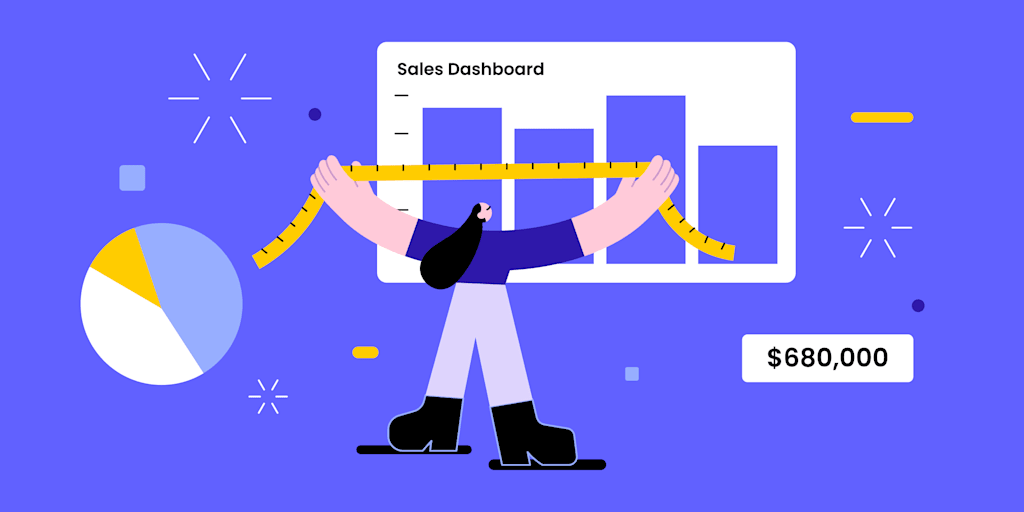Organizations put significant effort into defining objectives and building a strategy. But execution is where most teams fall short.
Without clear ownership, visibility into progress, or a unified way to measure success, momentum tends to stall. Priorities shift without warning. Resources are misallocated. Initiatives drag on, or fail entirely.
Key performance indicators (KPIs) are a critical piece of the solution. They help translate business focus into measurable outcomes across the organization.
This article breaks down how enterprise teams can use KPIs to bridge the gap between planning and execution. You’ll learn how to define high-impact metrics, coordinate teams around them, and monitor performance with confidence using monday work management.
What is a KPI?
A KPI, or key performance indicator, is a measurable value that tracks how effectively your organization is achieving a specific business objective. For example, “Increase average deal size by 12% in Q3” is a KPI tied to a revenue goal — one of many key business objectives.
Unlike general metrics, KPIs are tied directly to business strategy. They’re purpose-built to give you a clear picture of performance over time and drive informed decision-making at the executive level.
Strong KPIs are:
- Specific to an objective
- Owned by an accountable team or individual
- Regularly reviewed and acted on
- Quantifiable and based on reliable data
Let’s say your enterprise is launching a new regional product line. You can track KPIs like time to market, supply chain lead times, and early customer satisfaction scores to evaluate the success of that launch. These KPIs reflect broader business processes, not just operational activities, and signal whether strategic objectives are being met.
KPIs help project managers and leadership teams stay coordinated across functions, allocate resources effectively, and course-correct as needed. When measured and shared consistently, they create a common language that connects vision to outcomes.
The anatomy of a KPI: 5 core elements
Every effective KPI includes 5 key components. These elements ensure the metric is tied to real outcomes and can be tracked consistently across the organization — whether you’re measuring customer satisfaction, evaluating project performance, or improving marketing efforts.
- Measure: The quantifiable metric you’re tracking (e.g., churn rate, lead velocity, feature adoption)
- Target: The defined goal or benchmark for success
- Data source: Where the data comes from and how it’s collected
- Reporting frequency: How often the KPI is reviewed and evaluated
- Owner: The individual or team responsible for driving and reporting on progress
Clear KPIs eliminate confusion. When a performance goal is tied to a single owner, with consistent reporting and reliable data, teams can act quickly, and leadership can make decisions with greater confidence. Consistent, trustworthy data sources are essential — without confidence in the inputs, even well-structured KPIs lose their impact.
What is the difference between KPIs and OKRs?
Why KPIs matter for enterprise teams
Even the most well-designed business strategy can fall apart without alignment. In fact, misaligned priorities, unclear ownership, and lack of visibility contribute to nearly $2 trillion in failed initiatives every year.
For enterprise organizations managing dozens of strategic initiatives across regions and functions, KPIs serve as a critical control system. They give leaders a consistent way to monitor project performance, evaluate customer satisfaction trends, and make adjustments as needed.
When implemented well, KPIs create clarity across teams, support faster decisions, and keep progress grounded in measurable business outcomes.
Some of the key benefits of using KPIs across the business include:
- More visibility across teams: See impact at every level, from high-level strategic objectives to department-level business processes.
- Greater ownership and accountability: Assign clear responsibility to drive follow-through.
- Better strategic alignment: Connect outcomes to key business objectives and unify decision-making.
- Faster decision-making: Spot bottlenecks early and pivot before delays cascade.
- Higher levels of reporting confidence: Equip project managers and leadership with reliable insights for quarterly reviews and long-term planning.
When KPIs are tracked in one shared system, teams stay focused on outcomes that matter. Leadership gets the oversight they need, without slowing down delivery.
Types of KPIs, what they measure, and examples
Not all KPIs serve the same purpose. Some focus on long-term business goals. Others track day-to-day business processes or help forecast future risk. Grouping KPIs by type helps ensure you’re monitoring the right performance measures at the right level.
| KPI type | What it measures | Example |
|---|---|---|
| Strategic | High-level performance measures and long-term goals | Increase annual recurring revenue (ARR) by 20% |
| Operational | Daily business processes and near-term execution | Resolve 95% of IT tickets within 24 hours |
| Functional | Department-specific targets tied to key business objectives | Reduce marketing cost per lead (CPL) to $150 |
| Leading | Key indicators of future outcomes | Number of qualified potential customers added to the sales pipeline weekly |
| Lagging | Data that reflects results from prior time periods | Customer churn rate over the past quarter |
A strong KPI framework includes a mix of these types. Strategic and functional KPIs drive alignment with top-level goals. Operational and leading KPIs help project managers stay agile. Lagging KPIs confirm whether goals were ultimately achieved.
How to balance leading and lagging KPIs across teams
An effective KPI strategy includes both leading and lagging indicators. Leading KPIs signal future outcomes, while lagging KPIs confirm what already happened. Tracking both provides better insight into performance trends and decision-making opportunities.
For example:
- Leading KPI: Number of demos booked this month, which is an early signal of potential customer engagement and future revenue
- Lagging KPI: Closed-won revenue from last quarter, which reflects sales team success over a past time period.
To maintain balance:
- Use at least one leading and one lagging KPI per goal.
- Measure 3-5 KPIs per department per quarter to stay focused.
- Map lagging KPIs to business results, and leading KPIs to team actions.
This combination gives leaders visibility into what’s driving performance now — and what could impact delivery in the months ahead.
Understanding KPI subtypes: inputs, outputs, outcomes, and more
As organizations grow, KPI frameworks often require more granularity. Beyond strategy or operations, some teams benefit from classifying KPIs based on performance measures tied to different stages of work. This improves clarity and keeps metrics aligned to business needs.
| KPI subtype | What it tracks | Example |
|---|---|---|
| Input | Resources used to produce an output | Labor hours allocated to a product launch |
| Process | Efficiency or consistency of a business process | Average cycle time to approve vendor contracts |
| Output | The immediate result of a process | Number of contracts delivered to legal each month |
| Outcome | The broader impact of outputs | Customer retention rate over 12 months |
| Project | Milestones or progress in project performance | Percentage of completion for Q2 product roadmap |
| Risk | Key indicators of threats to success | Number of overdue critical tasks in portfolio view |
Using a mix of subtypes helps project managers measure both the effort that goes into an initiative and the results that come out.
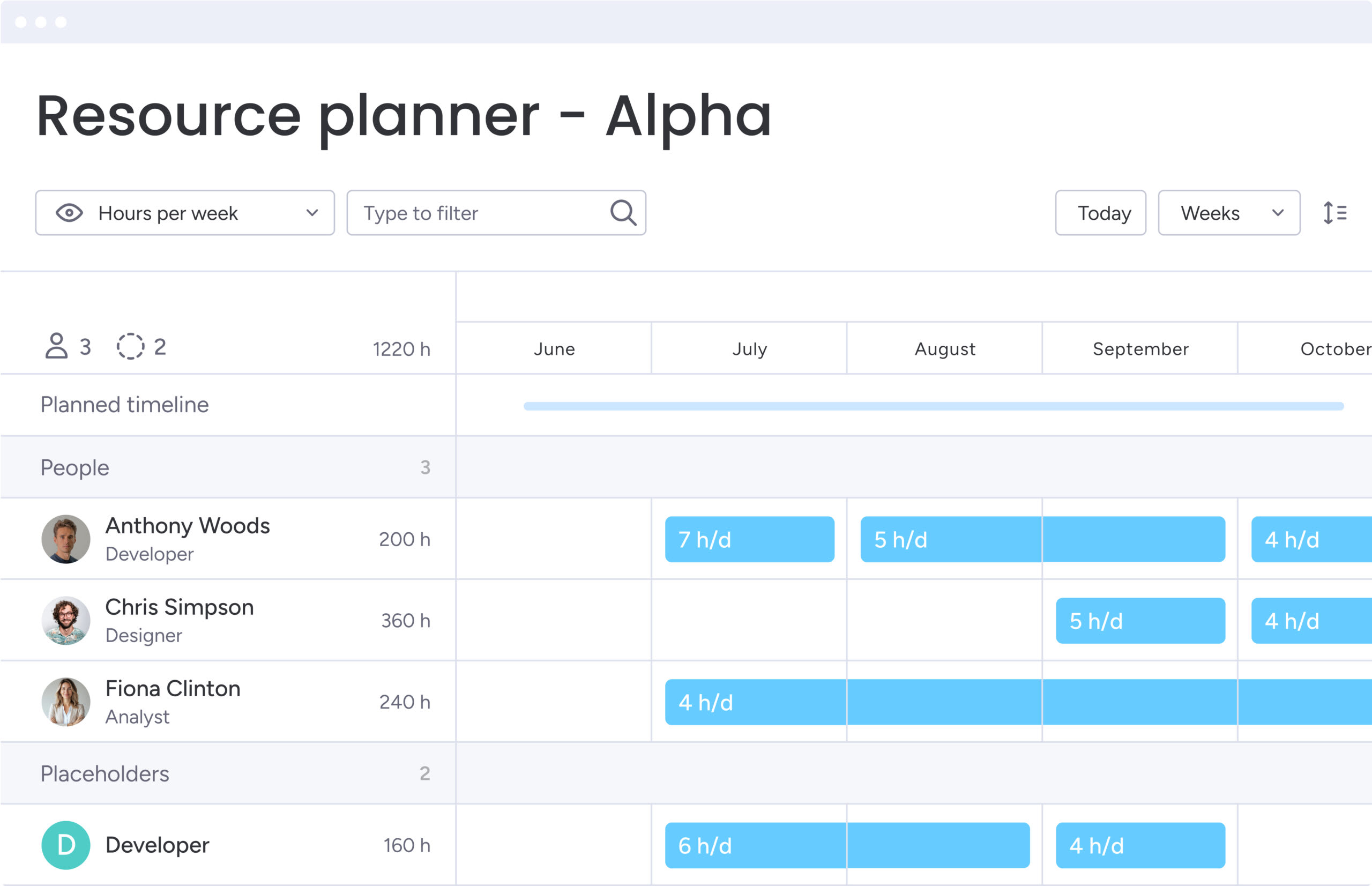
Where KPIs apply across the organization
KPIs aren’t limited to one layer of the business. To drive meaningful progress, they must span every level — from executive goals to frontline execution. Here’s how KPIs scale across the business:
- Company-level KPIs: These track progress toward high-impact business strategy goals. They help boards and executive teams understand enterprise-wide direction. Example: Increase total market share by 5% across North America by year-end.
- Department-level KPIs: These tie team efforts to measurable outcomes and support prioritization and resource planning, from marketing efforts to the sales team, HR, and finance. Example: Reduce average customer acquisition cost by 10% in Q3.
- Project-level KPIs: These measure progress within programs and initiatives and help surface what’s working and where teams need to pivot. Example: Deliver new product onboarding workflow in under 30 days with 90% internal adoption
When KPIs are tracked across the organization and aligned with both strategic objectives and team-level work, it’s easier to maintain momentum and course-correct quickly. A platform like monday work management supports this multi-tiered approach with dashboards, templates, reporting tools, and other KPI software features that scale with your business.
Want to learn more about visualizing KPIs? Check out how to use KPI dashboards.
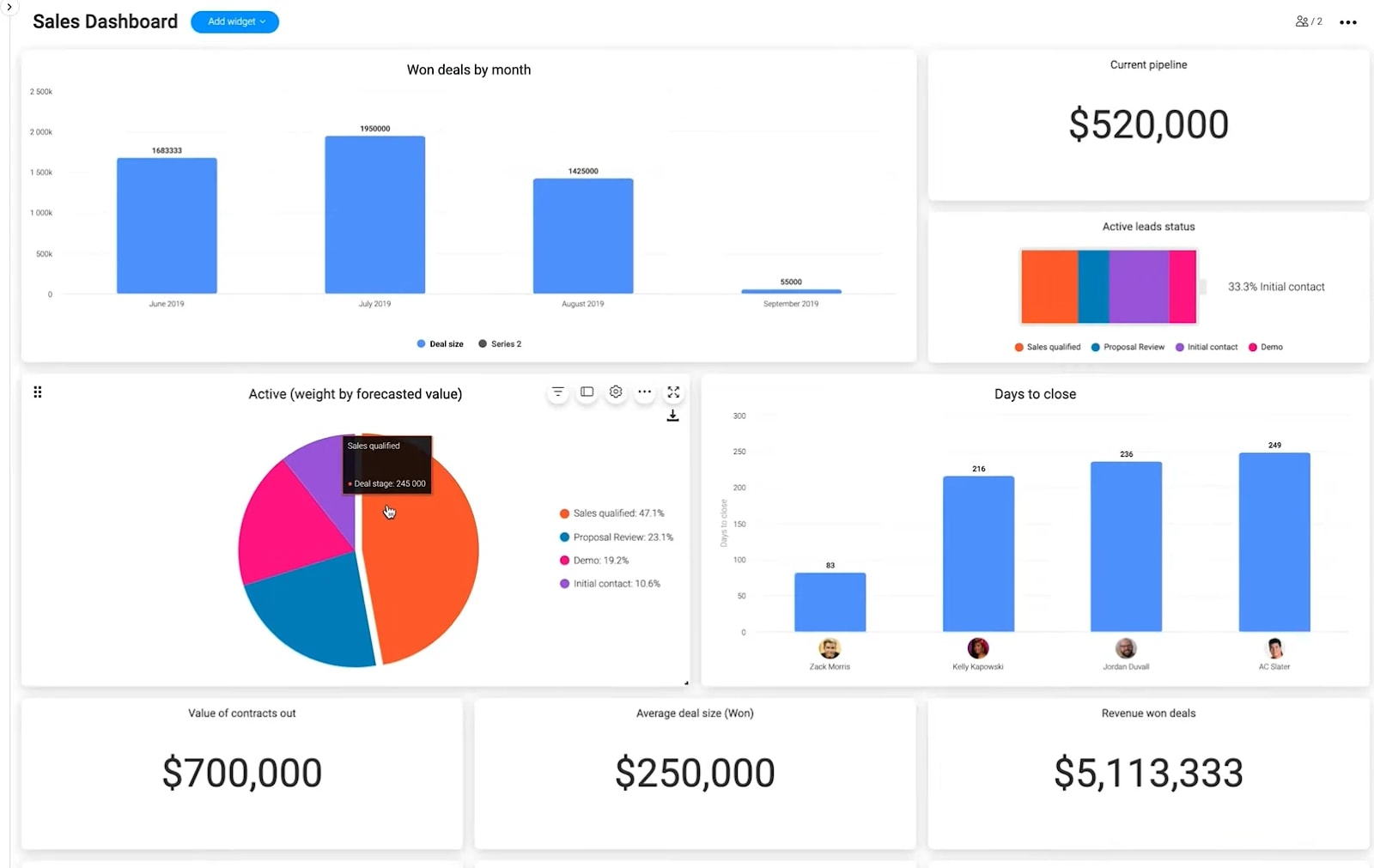
How to set KPIs that boost business performance
Setting KPIs isn’t a box to check. It’s a process that connects high-level goals to measurable outcomes across your organization. Here’s how to build KPIs that support performance, accountability, and follow-through at scale.
1. Connect to strategic priorities
Start with your business objectives. What are the top outcomes the company is trying to achieve this quarter or year? KPIs should reflect those priorities across each team and initiative.
For example, if one business goal is expanding market presence, relevant KPIs might include brand awareness metrics, new regional sales volume, or pipeline growth in target geographies.
2. Identify meaningful metrics
Choose metrics that actually reflect performance, not just activity. A marketing team might run hundreds of campaigns, but if the goal is to drive revenue, focus on metrics like MQL to SQL conversion or average deal size sourced from marketing.
Be cautious of vanity metrics. High numbers may look impressive, but they don’t always reflect meaningful progress. For instance, measuring total app downloads might miss more valuable insights like active user retention or product adoption by cohort.
3. Set realistic but ambitious targets
Every KPI should have a target. Clear targets help prioritize resources, create accountability, and keep teams focused and on track. Review historical performance and capacity to set short-term goals that challenge your teams without being disconnected from reality.
4. Assign ownership
Each KPI needs a clear owner. Whether that’s a team lead, a department head, or a cross-functional group, someone should be responsible for tracking the KPI and driving impact toward the target. Without ownership, KPIs lose accountability and often go unaddressed.
5. Define reporting cadence
Determine how often each KPI will be reviewed — weekly, monthly, quarterly — and what those review sessions will look like. Consistent, structured reviews make it easier to identify roadblocks and course-correct before goals fall off track.
6. Ensure cross-functional visibility
KPI performance shouldn’t be siloed. Sharing KPI dashboards across departments helps break down barriers, fosters a shared understanding, and aligns decision-making.
Teams move faster when they have clarity, and leadership gains confidence when performance is transparent.
7. Evaluate and prioritize KPIs at the executive level
Once KPIs are defined, executive teams play a crucial role in evaluating and prioritizing which ones will have the most significant impact. Not every metric deserves equal attention, and trade-offs are often necessary.
Start by clarifying which outcomes matter most. Whether the focus is market expansion, customer retention, or faster product delivery, the most effective KPIs are those directly tied to enterprise priorities.
Enterprise leaders should also encourage deliberate trade-offs. Teams can’t chase every metric at once. Prioritizing a few key KPIs creates focus and enables smarter resource allocation across departments.
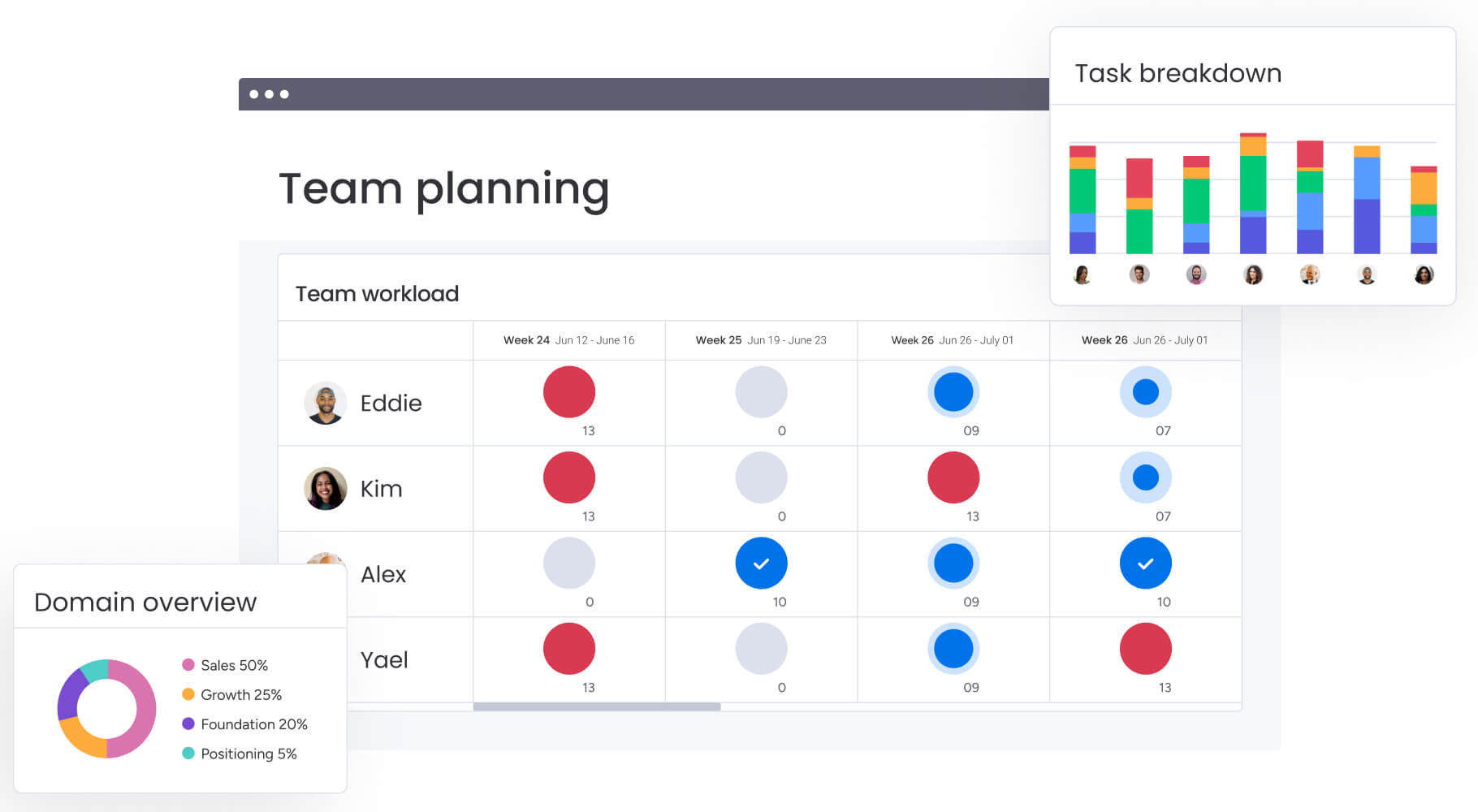
Every KPI should map clearly to an objective or key result. If it doesn’t support business outcomes or influence strategic direction, it likely isn’t worth tracking. Well-prioritized KPIs help leadership guide decision-making, measure what matters, and stay accountable to results, even in complex and fast-moving environments.
How the SMART framework levels up enterprise KPIs
The SMART framework helps leaders define KPIs that are both grounded in reality and actionable. Use it to ensure every performance indicator meets the criteria for effectiveness.
- Bad example: “Improve customer experience”
This example is too vague, lacks metrics, and doesn’t have a timeline. - Good example: “Increase the customer renewal rate by 8% quarter over quarter, based on last year’s peak performance, to support our customer retention strategy, by the end of Q2.”
This goal is specific, measurable, attainable, relevant, and time-bound!
| SMART criteria | Explanation | Example |
|---|---|---|
| Specific | Clearly defines what success looks like | Increase customer renewal rate |
| Measurable | Tied to a numeric or quantifiable goal | By 8% quarter over quarter |
| Attainable | Based on past performance or benchmarks | Based on last year’s peak performance |
| Relevant | Connects to business or departmental goals | To support our customer retention strategy |
| Time-bound | Includes a timeframe for completion | By the end of Q2 |
Want to learn more about managing SMART goals? Check out these SMART goal examples.
Examples of KPIs across departments and industries
Well-defined KPIs help every department and industry track what matters most — whether that’s growth, efficiency, customer satisfaction, or retention. Below are examples of commonly used KPIs, what they measure, and how teams apply them. Each one is paired with a clear, execution-ready target to drive action.
Marketing KPIs
- MQL to SQL conversion rate: This rate measures how efficiently marketing-qualified leads progress through the sales funnel, which identifies lead quality and marketing’s contribution to revenue generation.
Example: Increase MQL to SQL conversion rate by 12% by Q2 - Brand awareness score: This score assesses the effectiveness of marketing efforts in increasing visibility among target audiences, which helps gauge market presence and the reach of top-of-funnel campaigns.
Example: Improve brand awareness among enterprise buyers based on quarterly survey data - Cost per lead (CPL): CPL tracks how much is spent to generate a qualified lead, which helps optimize marketing spend.
Example: Reduce cost per lead for paid search by 15% in six months
Sales KPIs
- Average deal size: This KPI shows the average revenue per closed deal, which is useful for forecasting and strategic planning.
Example: Increase average deal size to $75,000 by the end of the fiscal year - Sales cycle length: Measuring the average time it takes to close a deal is helpful because it helps identify shorter cycles, which improve velocity and cash flow.
Example: Shorten sales cycle from lead to close by 10 days for strategic accounts - Quota attainment: This metric assesses the percentage of sales reps hitting their targets, which is a key indicator of sales team performance.
Example: Achieve 80% of quota attainment across sales reps for two consecutive quarters
Human resources KPIs
- Time-to-fill: This KPI tracks how long it takes to hire for open positions, which impacts productivity and cost of vacancies.
Example: Decrease time-to-fill for technical roles from 45 to 30 days - High-performer retention rate: This rate measures how well the organization retains top talent, which is a reflection of employee satisfaction and engagement.
Example: Increase retention rate of high performers to 95% over 12 months - Training completion rate: This KPI assesses participation in required programs like compliance, which supports workforce development.
Example: Reach 90% completion of annual DEI training company-wide
Operations KPIs
- Order fulfillment accuracy: Indicating the percentage of orders delivered correctly, this KPI is critical for supply chain efficiency.
Example: Improve order fulfillment accuracy to 98% across all regions - Shipping delay rate: This rate tracks the frequency of late deliveries, which impacts customer satisfaction and logistics cost.
Example: Reduce shipping delays to under 2% of monthly volume - Workflow utilization rate: Measuring how consistently teams follow standardized processes, this KPI supports scalability and consistency.
Example: Increase utilization of standardized workflows in logistics by 20%
Product KPIs
- Feature adoption rate: Showing how quickly users engage with new features, this rate reflects product-market fit and usability.
Example: Achieve 85% adoption rate of new feature within 60 days of launch - Bug backlog reduction: This KPI tracks the volume of unresolved bugs, making it a vital insight into product stability and user experience.
Example: Reduce bug backlog by 40% in the next two sprints - Usability score: This score captures customer satisfaction with product design or improvements, which reflects ease of use and helps identify friction points in the user experience.
Example: Increase customer-reported usability score to 8.5/10 on post-release survey
IT KPIs
- Help desk response time: This measures how quickly internal IT tickets are addressed, which affects employee productivity, satisfaction, and the speed of issue resolution.
Example: Reduce help desk ticket response time to under 2 hours - Legacy system migration rate: This rate tracks progress in modernizing tech infrastructure, which is critical for maintaining agility and security.
Example: Migrate 95% of legacy systems to cloud infrastructure by year-end - System uptime: This KPI measures the availability and reliability of critical systems, which is essential for maintaining business continuity and delivering a consistent customer experience.
Example: Maintain 99.99% uptime for enterprise-critical applications
Finance KPIs
- Days sales outstanding (DSO): This KPI measures how quickly a company collects payment after a sale, which directly impacts cash flow and overall financial stability.
Example: Decrease DSO to fewer than 40 days - Operating expense ratio: This ratio compares operating expenses to revenue, which helps identify cost-efficiency.
Example: Keep operational expenses under 15% of quarterly revenue - Forecasting accuracy: Assessing how close projections are to actual results, this KPI has the potential to improve planning confidence.
Example: Improve forecasting accuracy within ±3% across all departments
Customer success KPIs
- Customer satisfaction score (CSAT): This KPI measures how satisfied customers are after a specific interaction or milestone, which helps gauge service quality and identify areas for improvement.
Example: Increase CSAT score to 90+ among enterprise accounts - Net revenue retention (NRR): NRR measures revenue growth within existing accounts by factoring in expansions, renewals, and churn, offering a clear picture of account health and long-term customer value.
Example: Maintain NRR above 115% across strategic segments - Support ticket resolution rate: This KPI measures how efficiently customer issues are resolved, which is critical for building trust, improving satisfaction, and reducing churn.
Example: Resolve 80% of support tickets within 24 hours
Industry-specific KPI examples
KPI targets vary by industry, but the fundamentals stay the same. Here are a few examples:
- Healthcare: Maintain average patient wait times under 15 minutes to improve care efficiency and patient satisfaction.
- Retail: Maintain an inventory turnover ratio of 8x or higher to optimize stock levels and reduce holding costs.
- SaaS: Increase monthly recurring revenue (MRR) by 10% and keep customer churn below 4% to support sustainable growth.
- Logistics: Achieve on-time delivery rates of 95% or higher to ensure service reliability and customer satisfaction.
How to improve your KPI strategy over time
A good KPI doesn’t just show a number. It enables confident decision-making and forward momentum. Here’s how to tell if your KPIs are setting your teams up for success:
- Aligned to business objectives: KPIs should reflect enterprise priorities, not just activity.
- Actionable and measurable: You should be able to take action on the results and measure results objectively.
- Drives decisions, not noise: Each KPI should support timely decision-making or signal the need to course correct.
If a KPI isn’t prompting a conversation or change, it may be worth reevaluating. Business needs evolve, teams shift, and the metrics that once mattered may lose relevance. A strong KPI approach includes mechanisms to review and refine performance indicators on a regular basis.
- Conduct quarterly KPI audits: Revisit your KPI framework each quarter to ensure metrics still match with strategic priorities.
- Use performance reviews to surface gaps: Metrics that aren’t tracked, reviewed, or acted on often indicate unclear ownership or misalignment.
- Add leading indicators: Introduce predictive metrics that show whether lagging KPIs are trending in the right direction.
- Replace outdated or underused KPIs: If a KPI doesn’t drive action or influence decisions, remove it or restructure it.
Refining KPIs over time keeps your teams focused and your leadership connected with what matters most. As priorities evolve, monday work management makes it easy to adjust KPI frameworks without disrupting reporting workflows or dashboards.
The business value of getting KPIs right
KPIs do more than measure progress — they give enterprise leaders the clarity and control needed to operate with confidence. When connected across levels, KPIs help teams work toward operational results and provide leaders with meaningful visibility.
- Align cross-functional units: Create shared focus across departments working toward the same initiatives.
- Instill confidence in executive decisions: Ground planning and resource allocation in trusted data.
- Deliver measurable outcomes faster: Remove ambiguity and prioritize work that supports high-impact results.
Organizations that consistently monitor the right KPIs are better equipped to meet goals, adapt quickly, and report momentum with confidence.
The challenges of KPIs and how to overcome them
Although KPIs are essential for tracking progress, they can introduce challenges when not applied within the right structure. Left unchecked, even the most well-intentioned metrics can lead to misalignment, delayed decisions, or incomplete views of performance.
Over-reliance on lagging indicators
One common issue is an over-reliance on lagging indicators. These types of KPIs show what’s already happened, which limits your ability to proactively manage performance. Adding leading indicators, such as deal velocity or product adoption in early cohorts, can help teams identify potential issues before they escalate and take action before outcomes are affected.
KPIs disconnected from strategy
Even when KPIs are well-defined, they lose impact if they aren’t tied to organizational goals. When metrics live in isolation, they create confusion around priorities and ownership. To stay focused, every KPI should map to a broader business objective or initiative. Using connected dashboards and executive views helps ensure every metric supports outcomes that matter.
Siloed reporting across teams
In many organizations, reporting happens in silos. Teams track performance in different tools, with no shared view across functions. As a result, coordination suffers and blind spots appear. Standardizing KPI templates and creating a single source of truth with shared dashboards makes performance easier to monitor and act upon.
Manual processes slow progress
Outdated reporting processes can slow decisions and undermine even the best KPIs. When teams spend hours gathering data and compiling updates, decisions get delayed. More importantly, insights arrive too late to be useful. Automating updates and building live dashboards gives stakeholders the ability to monitor what’s happening now, not what happened last month.
Strong KPI strategies are powered by systems that enable visibility, adaptability, and alignment. When teams are equipped with the right tools, they can spend less time on reporting and more time making meaningful progress.
Achieve alignment: Connect KPI measurement to execution with monday work management
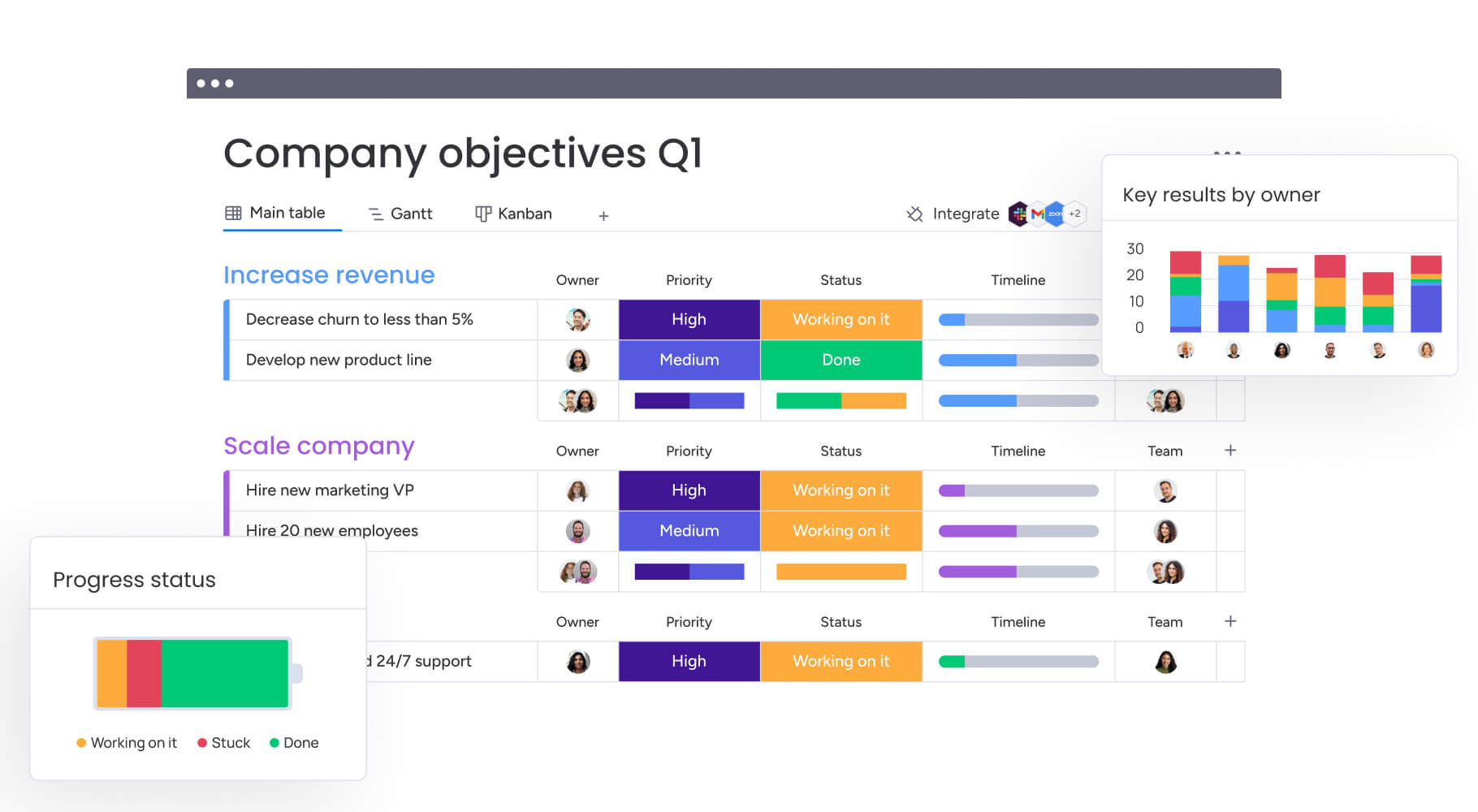
Enterprise leaders need clarity to move fast and confidence that their teams are focused on the right outcomes. Without a centralized way to track KPIs, goals get buried in disconnected spreadsheets and fragmented systems. Visibility disappears, and execution stalls.
A platform like monday work management provides a structured, flexible way to measure KPIs across all levels of the organization. From company-wide objectives to department or project-level goals, every performance metric is tied back to a shared, measurable outcome.
KPIs in monday work management aren’t static fields — they’re dynamic, connected to workflows that teams use every day. Each KPI connects directly to the workflows teams already use.
KPI owners can view updates live, get alerts when targets are at risk, and manage dependencies without switching tools. This keeps everyone accountable, on the same page, and moving fast, without waiting for the next monthly report.
Here’s how monday work management helps leaders track and operationalize KPIs effectively:
- Real-time dashboards: Visualize performance across teams and functions with customizable dashboards built for scale.
- Custom reports: Share performance updates with stakeholders using tailored reporting views that reflect the KPIs that matter most.
- Workflow automation: Automate repetitive tracking tasks to reduce manual effort and ensure KPI data stays up to date.
- Alerts and escalations: Set conditions that flag at-risk metrics, notify key stakeholders, and trigger follow-ups automatically.
Templates in monday work management help teams customize KPIs by function or vertical, while dashboards and alerts keep performance front and center. Additionally, role-based permissions support enterprise governance, ensuring KPI data is standardized, secure, and accessible to the right stakeholders at every level.
When your KPIs live inside monday work management, they become part of how work gets done. You get the visibility you need — without slowing down your teams.
Create a KPI report to drive action
Reporting on KPIs isn’t just about presenting numbers. It’s about enabling decision-makers to act quickly and confidently. Whether you’re reporting up to the executive team or reviewing progress with department leads, a strong KPI report provides clarity, not clutter.
Here are the core elements to include:
- Visuals and trends: Use charts, graphs, and time-based comparisons to show whether performance is improving or declining.
- Summary insights: Call out what’s working and where issues are emerging, without requiring readers to dig through raw data.
- Actions and risks: Highlight specific next steps, blockers, or resource needs. Help teams and leaders move from analysis to implementation.
Using monday work management helps you stay on top of performance with reporting dashboards, live data syncing, and filters that let you tailor each view to its audience — whether it’s a leadership deck or a weekly check-in.
Go from KPIs to results faster with monday work management
Measuring performance is only part of the equation. Achieving outcomes at scale depends on having the visibility and systems to translate insight into action across the entire organization.
The monday work management platform is built to connect high-level strategy with day-to-day work, providing a foundation for KPI success across every team.
With shared dashboards and flexible workflows, teams stay focused and move together around the metrics that matter most. Leadership gains full visibility into progress and risk. And as priorities shift, the system flexes to support faster decisions and sharper execution.
This helps leaders go from planning to results faster. Try monday work management to see how it helps your organization build and scale a performance-driven culture.
FAQs
What is a KPI with an example?
A KPI (key performance indicator) is a measurable value that tracks movement toward key targets. For example, “Reduce customer churn by 5% this quarter” is a KPI tied to a retention goal.
How do you identify KPIs?
Identify KPIs by starting with a business objective, then selecting metrics that reflect meaningful progress. Prioritize metrics that are quantifiable, time-bound, and directly influenced by your team.
What KPIs should you be tracking?
Track KPIs that align with your business goals. These may include financial, operational, customer satisfaction, or employee performance metrics, depending on your team’s focus.
What’s the difference between metrics and KPIs?
All KPIs are metrics, but not all metrics are KPIs. KPIs are metrics chosen because they reflect critical progress toward specific goals.
How often should KPIs be reviewed?
Review KPIs weekly, monthly, or quarterly, depending on the pace of the work. Consistent reviews help teams adjust quickly and stay aligned with business goals.
